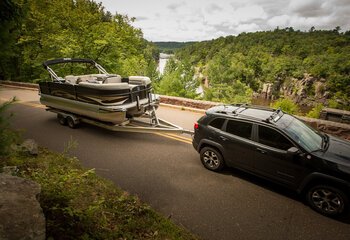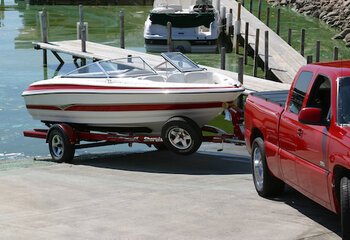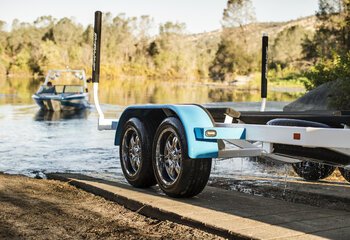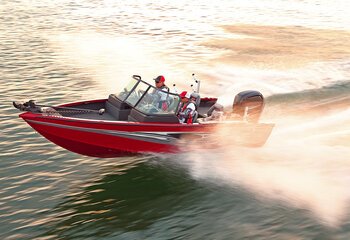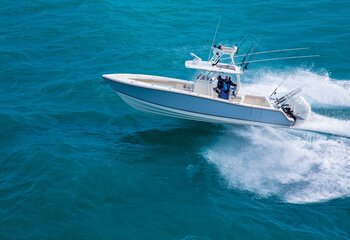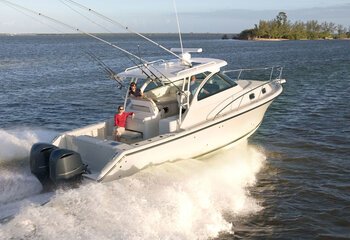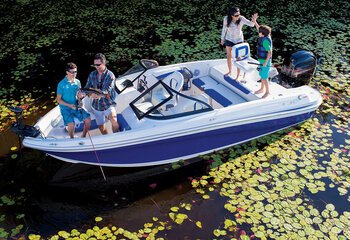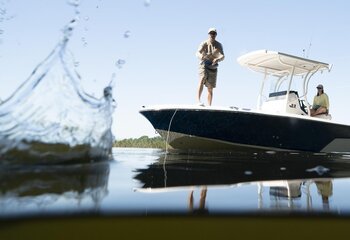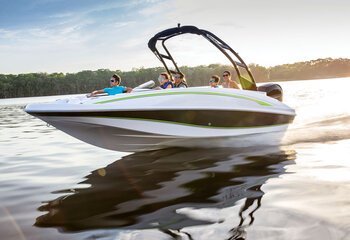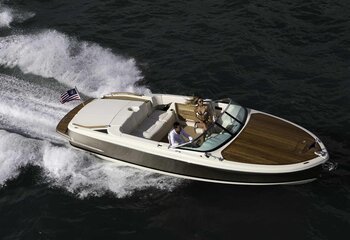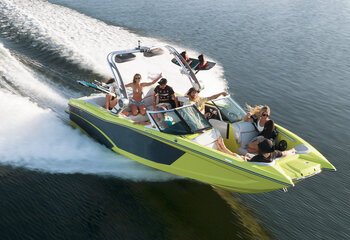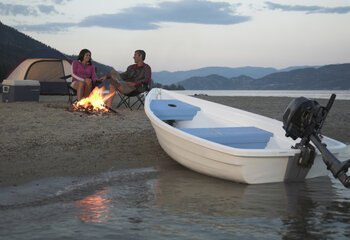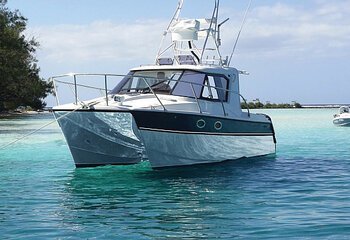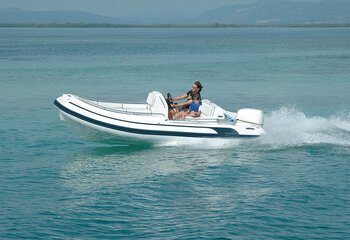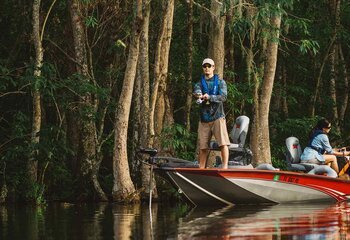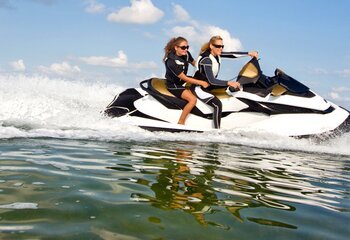Boat Towing: How to Trailer a Boat
With a trailerable boat, you’re free to boat on just about any lake, river, bay or inlet. Trailering is great way to explore different waterways in your state or region and it’s also the most affordable way to store your boat.
Let’s say our Boat Finder tool led you to the perfect trailerable boat, you’ve just signed on the dotted line, and now you’re ready for some serious aquatic adventures—just as soon as you figure out how to keep towing and trailering safe and easy. Don’t worry, there’s no great mystery to trailering a boat once you’ve got the basics figured out.
Towing a Boat
Learning how to tow a boat isn’t nearly as difficult as one might imagine. Read our complete guide on How to Tow a Boat for step-by-step instructions.
We’re going to assume you already compared the weight of your boat/motor/trailer package with the towing capacity of your vehicle, to make sure your tow vehicle could handle the job. If you haven’t, everything else should come to a screeching halt until you do so. It’s imperative that you never try to trailer a boat with an insufficient tow vehicle, and looking up the pertinent weights and capacities only takes a moment.
Okay—you have a safe package within all weight restrictions, and you ran through the pre-trip checklist. You’ve arrived at the lake? Excellent – we’re glad to hear that you had a safe, uneventful trip to the boat ramp. Now, it’s time for…
How to Tow a Boat: Step-by-Step Guide
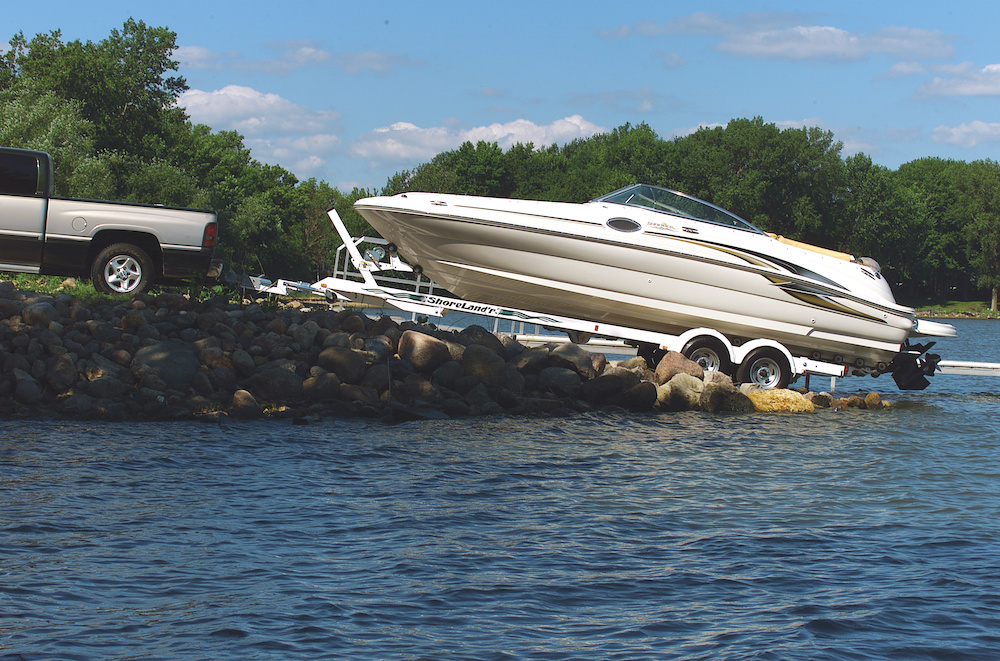
How to Backup a Boat Trailer
Now it’s time to back down the ramp, which some people consider the biggest challenge of all.
- To make it easier, pull forward far enough that you start backing with the truck and trailer in alignment.
- Then make tiny incremental steering corrections as you’re backing up a boat trailer; over-steering is often the cause of a botched backing job.
- Remember that the trailer will swing in the opposite direction of where you steer; some people find it helpful to place their hands at the bottom of the wheel, while reminding themselves to move their hands in the direction they want the trailer to go.
- When the back of the boat begins to float, you may be able to release the bow eye and motor or tug the boat off the trailer.
Every rig is a bit different and different ramps have different grades; in some cases you may need to back down until the tow vehicles’ rear tires are getting wet and in others you may not need to back down nearly as far. Just remember to take your time and don’t be afraid to move the rig farther down the ramp if necessary if the boat doesn’t float free on the first try.
Launching a Boat
Getting the boat off the trailer at a boat ramp is far easier than removing a boat from a trailer on land—the water and the boat’s buoyancy will do all the work for you. Though it may seem daunting the first few times you do it, you’ll be launching that boat like a pro in no time. Before you launch, however, there’s some preparation to be done:
- Remove all tie-downs and ropes (but not the winch hook, or the boat could slide off the trailer prematurely).
- Add a rope to the boat so you can secure it at the pier once it’s off the trailer.
- Load any gear hauled in your tow vehicle into the boat.
- Put in the drain plug.
- If your trailer has incandescent lights, unplug them from the tow vehicle (otherwise, they can heat up when you step on the brakes and then pop when submerged in cool water).
As a matter of boat ramp etiquette, it’s considered polite to pull over in the parking lot to make all your preparations. That way other boaters can continue using the ramp, as you get prepped.
How to Launch a Boat: Step-by-Step
Retrieving the Boat & Loading it Back on a Trailer
Loading your boat on a trailer is a lot easier than most people would guess. The trickiest part is submerging your trailer to the ideal depth. It should be just about as deep as it was when taking the boat off, and in most cases, about two-thirds of the trailer will be submerged while one-third remains out of the water. Don’t submerge the trailer too deep, or the bow of the boat may float over the bunks and go off to the side.
Some rigs are designed for the boat to be driven directly onto the trailer, while others are meant for the boat to be floated on as you control it with ropes. In both cases simply aim the boat down the centerline, and (gently) drive or pull it on until it stops. Then attach the winch to the bow eye, and after making sure the anti-reverse ratchet on the winch is engaged, crank it up the rest of the way up until the bow lays firmly on the bow stop. If you can’t get it all the way up consider backing the trailer down a bit deeper, if possible.
When you’ve pulled the boat up the ramp, inspect it to make sure it’s centered on the trailer. If it isn’t, with a small, light boat you may be able to lift and push the boat to adjust its position. With larger boats, you may need to back down into the water again to make the adjustment.
How to Load a Boat on a Trailer
Basic Boat Trailering Tips
Here's are a few more boat trailering tips to make sure the trip goes smoothly...
- Always allow extra following distances and braking times.
- Never start like a jackrabbit. Even if you went through the checklist and know the boat is securely tied to the trailer, things can break… and more than one boat has slid off the trailer and onto the roadway, thanks to a lead foot when the light turned green.
- Swing wide around turns, to avoid clipping the curb with a trailer tire.
- If you sense any swaying in the rig, pull over and redistribute weight. The tongue weight (how heavy the very front of the trailer is) should be between 10- and 15-percent of the overall load weight. If it’s not proper the trailer can sway from side to side, and swaying can lead to accidents.
- Change lanes very slowly. You may not be able to see cars directly behind your boat (unless you’re towing a small boat) and they may sometimes whip out from behind you and accelerate unexpectedly.
What Do You Need to Tow a Boat?
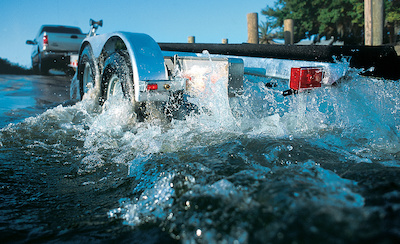 Whether you’re towing a boat long distances or just heading around the corner, all you need to tow a boat is...
Whether you’re towing a boat long distances or just heading around the corner, all you need to tow a boat is...
- A capable tow vehicle
- Reliable tie-downs for the stern.
There is some additional gear you may want to consider getting, however. A Transom Saver will help support the engine’s lower drive unit, and relieve stress on the boat as you hit bumps on the highway. And side mirror extensions can be very helpful if your tow vehicle doesn’t have over-sized towing mirrors.
Certified Trailers
The National Marine Manufacturers Association (NMMA) operates a trailer certification program to help boat trailer manufacturers comply with established industry standards and federal safety regulations. The NMMA Certified Trailer program gives boat trailer owners peace of mind, by helping them identify trailers that comply with applicable federal highway regulation, industry standards and State brake requirement. Trailers are certified in several areas, including of VIN plates, capacity ratings, couplings, safety chains, lighting, winches, brakes, and registration procedures.
Highly trained third-party inspectors visit the manufacturer each year and physically inspect boat trailer models, ensuring compliance to all certification requirements.
You can view our complete list of certified trailer manufacturers for more information.
State Laws About Towing your Boat
State laws vary regarding towing. Braking systems, maximum width, and the presence of safety chains are just a few examples of regulations that can differ from state to state. Before towing, be sure to check your own states’ laws.
To learn more, read Boat Trailer Laws, Rule & Regulations.

